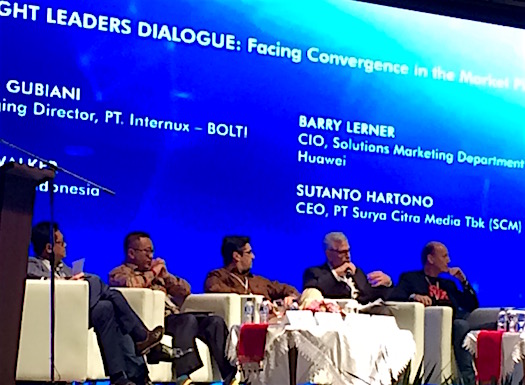In this morning’s Thought Leaders Dialogue at Broadcast Indonesia, a range of leaders tackled the question of convergence in the market place.
Thomas Jul, CEO & Head of Indonesia and Timor Leste, Ericsson, led discussion from a range of panelists around this issue.
The panellists were:
Alex J. Sinaga, CEO, PT Telekomunikasi Indonesia
Alexander Rusli, CEO, Indosat Ooredoo
Devid Gubiani, Managing Director, PT Internux – Bolt!
Cam Walker, CEO, iflix Indonesia
Barry Lerner, CIO, Solutions Marketing – South Pacific Region, Huawei
Sutanto Hartono, CEO, PT Surya Citra Media Tbk (SCM)
Key points from the discussion included:
Today’s media must focus on brand engagement. To do so requires these elements: simplicity, identity, quality, privacy, and good quality products.
“We are heading for a mobile-first society,” Alexander Rusli told delegates. “Our lives revolve around these devices. The smart device is getting bigger, which means that more things can be done on these devices.”
The largest driver of mobile usage is video.
Joddy Hemady from Telekomunicasi Indonesia says his company is concentrating on three areas: fixed broadband, mobile broadband and Satellite. In Indonesia satellite “will play an important role to cover all of Indonesia’s market needs,” according to Hemady.
“We began with fixed broadband because it can deliver better benefits then mobile at this time. But we are also trying to tranform our mobile network to accommodate all the demands in the future.”
Alexander Rusli said “consumers don’t care how you provide them the service. If you can harness disruptive technology to enable the best service, the user will take it on…
70% of our network traffic is video, but the [good] content of the video determines how long they stay with us.”
Barry Lerner, CIO of Huawei said smart mobile devices “have one thing in common, they ensure we are online all the time. We can get instant information and we can make decisions immediately – devices are changing the way we think and do business.”
Where’s the money in all these trends, asked Thomas Jul. Answers included:
The money is coming from the end user. End users don’t want to be locked into a contract, they want what they want and are willing to pay for that, but not for bundled services and things they don’t want.
Money is being made by increasing the user experience, by making things easier for the end user to do what they want to do.
The money comes from understanding the end user and giving them good user experiences.
The money comes not just from the customer but also from those who want to reach the customers. We all need to work together to make that experience seamless. We also need to cut our costs and provide services with the least overhead. Customers will only buy what they want and advertisers want to target fine segments of customers so as not to waste money.
In a final thought, all the leaders agreed with this sentiment:
“Regulation is necessary, but it can never be as fast or as innovation as technological change, so we need regulators to leave space for innovation.”
You don’t have to be a big company to create something big, you can be one person with a server and a good idea if you have the right support, policies and regulation and an it workforce capable of putting your idea into proactive.
Interesting exhibitors at the Technology show included those pictured below.
Notably, Huawei had a big presence, and LiveStream showed off an impressive portable streaming set up.
LiveStream’s portable video streaming is generated from the portable equipment displayed, and the company also has a platform that can host the video, which can be ‘white-label’ embedded into a client’s webpage. See www.coremedia.co.id for more details.

